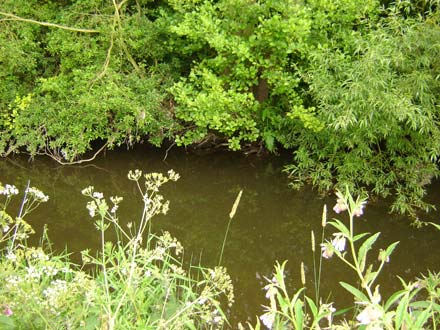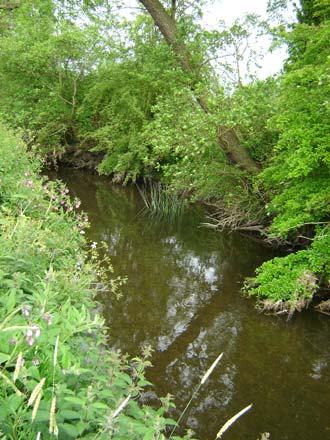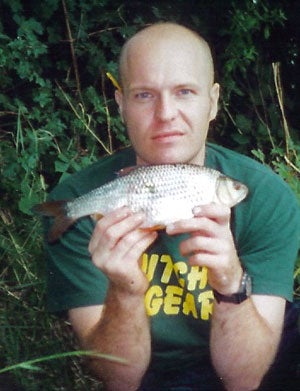| MARK HODSON | |
An angler since he can remember, Mark Hodson almost literally lives, eats and breathes fishing. A match angler in his youth, fishing for the junior Starlets, he turned to the dark side and joined the ‘floppy hat’ brigade in his college years. He worked in the tackle trade for ten years, on a part time or full time basis at Chaplains, one of Birmingham’s busiest tackle shops and managed the specialist department there for two years. He now fishes just for fun, although the ‘floppy specialist hat’ still dominates his angling, his writing concentrates on getting the maximum enjoyment from your angling and trying something different from the norm. |
| SMALL RIVER, BIG ADVENTURE I don’t quite know what it is about the start of the season but it’s the same every year, despite all the planning and preparation it is inevitably an anti-climax. Due to all my favourite stretches of river looking horribly low and lifeless I had decided on fishing a lake that still retains a closed season for tench. In preparation, over the 10 days leading up to the opening day I had been raking and prebaiting two swims every other day. On the last two occasions I had seen some good tench up to 7lb come into the swim, just as I dragged the rake out, and went down on the feed even as the bait was raining down on them from above. It all looked perfect for dawn on opening morning, and it was, I was fishing just as the sun rose, small pin prick bubbles started drifting lazily to the surface as the tench tucked into their opening day free meal, my waggler started to dance like a drunken sailor as the fish dumped against the line, and then…. it all went wrong as the mother of all marker floats landed feet away from where I was fishing.
The proceeding bow waves as the tench fled the swim in a blind panic did make pretty patterns but this did not quell my anger as I marched around the lake to hang, draw and quarter the culprit. After a little investigation the guilty party was found but as I saw from his swim, which was only 50 yards away I had secreted myself and my gear so well there was no way he could of known I was there. With my best opportunity gone and my fishing ‘karma’ all over the shop I tried to make amends but by 10am I was at home sulking and swearing never to fish the opening day again. By dinnertime my enthusiasm had returned and I was planning my next session before work the next day, which was to be completely different both in venue and tactics to my disastrous tench session. Over the closed season I had taking a great deal of interest in a tiny river that meanders its way through the farmers fields around where I work. Like most anglers I am drawn to water like a moth to light, and once sighted a potential fishing venue has to be investigated. This tiny river once was the sole property of some very elitist local fly fishing clubs but over the last 20 years, apart from the local kids and the odd heron, no-one had given the tiny stream a second look. I started to walk parts of the river where I could get access and for the large part it is only 6 to 18″ deep. But every 200 yards or so I would find the occasional deep hole that held wondrous secrets, secrets that gave themselves up thanks to a great deal of stealth and a pair of Polaroid’s.
Since mid-May I had continually returned to one spot which I had named the ‘deep roots’, this as you can see from the picture was an obvious name, as the swim is about 2 1/2 feet deep with tree roots and an undercut bank offering plenty of cover for fish. This is the only swim for fifty yards either upstream or downstream with any depth and cover and so it held fish all of the time. The fish were the most sensitive, shy and knowledgeable fish I had ever seen at close quarters. The years spent surviving in such an small and exposed river had made them the ultimate challenge. I quickly realised I had to ditch my usual footwear, so the waders and walking boots were swapped for a pair of soft bottomed training shoes so I could tread as lightly as possible. With those I could creep up behind the masses of wild flowers and long grass that line the banks and see the fish in the ‘deep roots’. I would visit the swim up to twice a week at dawn or dusk, and noticed that the same fish were always present. There was a small shoal of chub, only six in number and all 11/2 to 2 lb in weight, two brown trout, both looked just over a pound, a smattering of small dace and roach but what intrigued me most were four fish that showed themselves only very occasionally but thanks to a fly hatch at the start of June I got a good look at them. Three of the fish were large roach that all looked well over a pound, the biggest nearer two pound. The fourth fish was a huge dace, well over a pound, but they were the shyest fish in the swim, and the first to dart for cover and not re-appear at the sign of any disturbance. It was these four fish I wanted to catch and I devised a cunning little plan to do so. My main problem was that whenever I dropped a bait into the swim the two trout or one of the chub would grab it first. Continual feeding of bread would bring the three roach and the dace out into a catchable position just off the roots, but I knew it would be impossible to get a hookbait to them without the chub or trout grabbing it first and being hooked, ruining the swim. However I found that if I fed the swim with pieces of bread for twenty minutes the greedier trout and chub would follow the majority of the feed slowly to the back end of the swim leaving my four target fish at the head where I could slowly roll a hook bait down onto their noses. The chosen hookbait would be half a worm, irresistible to all fish (especially large roach and dace), also tough enough to withstand a minnow or small fish that fancy’s a peck at it and guaranteed to stay on the hook when ‘trundled’ into position; this was essential because I would get only one, or at best two casts before the fish became aware of my presence. The end tackle would be a simple size 16 Drennan Super Specialist hook tied direct to 4lb Berkley XL clear line, with a single AAA shot, 12″ from the hook, which with the worm provided just enough weight to flick the bait into position. The rod was a simple 10ft quivertip with a 11/2 oz tip. Not that the tip mattered as bite detection would be dependant on me actually seeing the fish take the bait or feeling for a bite as by the time the bait had been rolled into position the rod would be pointing directly at the bait. Anything longer than 10ft was just too unwieldy in the swim and undergrowth. A landing net, my Polaroid’s and a few bits of spare tackle and bait were carried in my stalking jacket and that was it. And so at dawn on the 17th June I crept on my hands and knees into position, and for twenty minutes I flicked 10p size pieces of bread into the shallow run at the head of the swim. After peeking above my chosen cover I could see that the two trout and the chub were, as planned, at the tail end of the swim mopping up all the larger pieces of bread and, as also planned, the three roach and the dace had come out of hiding and were sitting just off the roots picking at the fragments of bread that had broken off the larger pieces as they drifted past.
I slowly lifted the rod above the bankside cover, got onto my knees and flicked the bait into the head of the swim, slowly feeding line from the reel I rolled the half a worm to within three feet of my chosen four fish who were lined up four abreast like four small boats in a harbour, slowly I let the worm drift downstream a little more. But to my horror I saw some of the chub and the two trout moving back up the swim. While I was moving the hookbait into position no feed was going into the swim and the chub and trout had started to move back up the swim in search of more feed. One of the trout came alongside my target four fish and for a minute I thought it was going to dart forward and grab the hookbait. So I pulled the worm back upstream and as I did so, to my amazement one of the smaller roach powered forward and I saw its gills flare as it sucked in the worm. I was so shocked that I didn’t even strike, it wasn’t until I felt the line tightening across my index finger that I lifted the rod and hooked the fish. Immediately the swim emptied of all other fish as they all shot for cover, disturbed by the hooked roach and the fact that I had to stand to play the fish. The fish weighed 1lb 11oz, a cracking fish for the size of the water and I am now sure that the bigger of the three roach was well over two pounds and the dace about a pound and a quarter. I was delighted to have caught this old warrior of a fish that had evaded all the dangers in its little home for all those years. When released it disappeared straight into the deep roots to join its mates once again.
The time spent watching and feeding various baits to the fish in this little river has taught me so many lessons that I will take into the rest of my fishing. The main one is that stealth is far more important than concealment, slow deliberate movements are essential, camouflage is not, if you watch a heron hunt you’ll not notice it move, yet it does ever so slowly, this enables it to stay unseen despite having white plumage and being directly above the fish. I have experimented with this and have found that whether wearing camouflage, bright yellow or white tops it is the movement that betrays our presence, not our outline. Now I won’t name this little river that looks no more than a brook or drainage ditch to some, as I have become fiercely protective of it, and its inhabitants. I have returned since, not to fish but just to check the swim, and I am currently priming two other swims, one of which has some larger chub in it and a brown trout that looks well over three pounds. But everyone will have similar small streams close to them that feed their main rivers where they usually fish, and if you spend a few hours looking in the right places these little private paradises will give you a lot of fun, the sort you had when you went fishing as a kid, and a massive advantage when targeting your chosen quarry on larger waters, as you’ll learn more about your quarry from watching fish like these for an hour, than fishing for a day. |


















